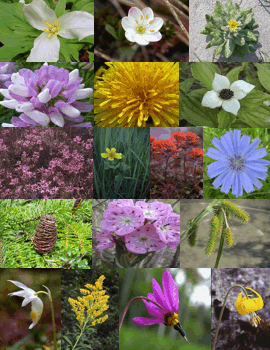Summary:
Features include 1) a spherical to irregular fruitbody with a whitish, dry surface having yellow tufts or fibrils that are quite dense when young, 2) a spore mass that is white becoming cream or gray and soon dark brown, 3) a usually absent columella, 4) a point of attachment that is usually small and inconspicuous, 5) underground growth under Eucalyptus, 6) large truncate spores with isolated warts and short ridges, the spores inconsistently dextrinoid and with a conspicuous perisporium that is sometimes loose and flanging, 7) 1-spored and 2-spored basidia, and 8) a peridiopellis with an outer layer of golden, thick-walled hyphae and an inner layer of colorless interwoven thin-walled hyphae, mainly with cylindric end-cells, the end-cells forming a trichoderm as they merge gradually with the outer layer.
Collections were examined from Oregon, California, Brazil, Chile, Uruguay, South Africa, Australia, and New Zealand, (Dodge), and HI, France, Sri Lanka, and Australia, (Bougher). Note however that Trappe(13) do not list it for the Pacific Northwest. Shannon Berch has found it under eucalyptus in BC.
Outer Surface:
0.5-3cm across, angiocarpic, spherical, somewhat spherical, or irregular; peridium "white or cream with yellow tufts or fibrils which are often quite dense when young" but scattered or evanescent [fleeting] later, paler when old; dry, (Bougher(1)), 2-3cm across, somewhat spherical; white, turning yellowish to "light buff", drying "yellow-ocher" or "ochraceous buff"; innate fibrous, drying rugose [wrinkled], (Dodge)
Stem:
columella / sterile tissue "usually absent, when present forming a sterile basal pad, sparse dendroid sterile veins or a short, truncate columella", point of attachment often small, inconspicuous, (Bougher)
Interior:
"dry, with irregular empty locules"; "white at first then pale cream or grey, soon dark brown", (Bougher), spores mass ''becoming fragile, "Sudan brown" to "Argus brown", cavities irregular'', (Dodge)
Microscopic:
spores 13-19(20) x 7-11(13) microns, citriniform [lemon-shaped], subfusiform [somewhat spindle-shaped], elliptic, "verrucose with isolated irregular warts and short ridges", inconspicuous or up to 1 micron tall, spores inconsistently dextrinoid, bright yellow brown in KOH, perisporium "conspicuous (often yellow-brown in KOH), sometimes loose and flanging, not covering apex", spore wall usually thin, apex "smooth rostrate to rounded in some spores", apiculus "entirely truncate to sometimes cup-like or torn"; basidia 1-spored and 2-spored, 23-40 x 6-10 microns, clavate or cylindric, colorless, "soon collapsing with a yellow encrusting necropigment"; hymenium a closely packed palisade of colorless basidia, and basidioles (up to 23 x 13 microns); hymenophoral trama hyphae 3-4 microns wide, colorless or pale yellow (in KOH), clamped, parallel or slightly interwoven; subhymenium "narrow and poorly differentiated"; peridiopellis nongelatinized, 2-layered: outer layer of hyphae 4-15 microns wide, golden, thick-walled (1 micron), clamped, inner layer broad, of hyphae 3-7 microns wide, interwoven, colorless, thin-walled (<0.5 micron), clamped, mainly with cylindric end-cells "but some scattered vesiculose or pyriform end-cells up to 35 x 15 microns may also be present, end-cells forming a trichoderm as they merge gradually with the outer peridium"; clamp connections conspicuous in all tissues, (Bougher), spores 14.5-17 x 9.6-11.1 microns including utricle, elliptic-citriform [elliptic - lemon-shaped], roughened by an evenly applied, alveolate utricle [bladder-like covering] that extends to the base of the apiculus, dark brown, the young spores elliptic and smooth without utricle or apiculus but usually with a pedicel attached, in some apparently semi-mature spores, "the utricle is less closely applied above, having a flaring tendency"; basidia 2-spored, 15-18 x 11-13 microns, broad-cylindric, sterigmata short, about 2-3 microns long; septa thin, fragile, 12-25 microns thick, composed of colorless, thin-walled, parallel hyphae; peridium thin, 18-30 microns thick, colorless, "the outer part composed of loosely applied, yellowish hyphae", the inner part of more compact, stupose hyphae, (Dodge)
|
